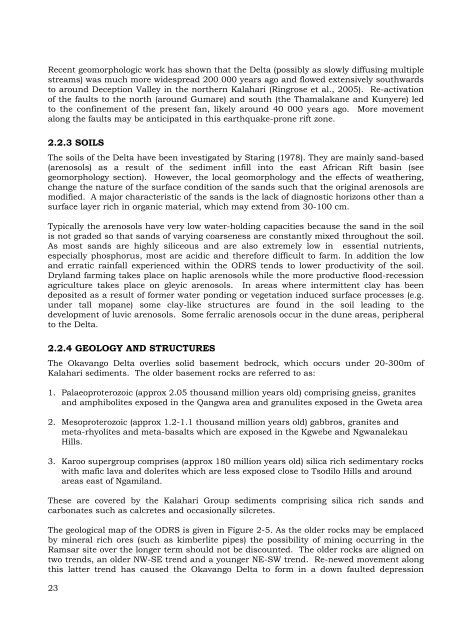Okavango Delta Management Plan - Ramsar Convention on Wetlands
Okavango Delta Management Plan - Ramsar Convention on Wetlands
Okavango Delta Management Plan - Ramsar Convention on Wetlands
You also want an ePaper? Increase the reach of your titles
YUMPU automatically turns print PDFs into web optimized ePapers that Google loves.
Recent geomorphologic work has shown that the <str<strong>on</strong>g>Delta</str<strong>on</strong>g> (possibly as slowly diffusing multiple<br />
streams) was much more widespread 200 000 years ago and flowed extensively southwards<br />
to around Decepti<strong>on</strong> Valley in the northern Kalahari (Ringrose et al., 2005). Re-activati<strong>on</strong><br />
of the faults to the north (around Gumare) and south (the Thamalakane and Kunyere) led<br />
to the c<strong>on</strong>finement of the present fan, likely around 40 000 years ago. More movement<br />
al<strong>on</strong>g the faults may be anticipated in this earthquake-pr<strong>on</strong>e rift z<strong>on</strong>e.<br />
2.2.3 SOILS<br />
The soils of the <str<strong>on</strong>g>Delta</str<strong>on</strong>g> have been investigated by Staring (1978). They are mainly sand-based<br />
(arenosols) as a result of the sediment infill into the east African Rift basin (see<br />
geomorphology secti<strong>on</strong>). However, the local geomorphology and the effects of weathering,<br />
change the nature of the surface c<strong>on</strong>diti<strong>on</strong> of the sands such that the original arenosols are<br />
modified. A major characteristic of the sands is the lack of diagnostic horiz<strong>on</strong>s other than a<br />
surface layer rich in organic material, which may extend from 30-100 cm.<br />
Typically the arenosols have very low water-holding capacities because the sand in the soil<br />
is not graded so that sands of varying coarseness are c<strong>on</strong>stantly mixed throughout the soil.<br />
As most sands are highly siliceous and are also extremely low in essential nutrients,<br />
especially phosphorus, most are acidic and therefore difficult to farm. In additi<strong>on</strong> the low<br />
and erratic rainfall experienced within the ODRS tends to lower productivity of the soil.<br />
Dryland farming takes place <strong>on</strong> haplic arenosols while the more productive flood-recessi<strong>on</strong><br />
agriculture takes place <strong>on</strong> gleyic arenosols. In areas where intermittent clay has been<br />
deposited as a result of former water p<strong>on</strong>ding or vegetati<strong>on</strong> induced surface processes (e.g.<br />
under tall mopane) some clay-like structures are found in the soil leading to the<br />
development of luvic arenosols. Some ferralic arenosols occur in the dune areas, peripheral<br />
to the <str<strong>on</strong>g>Delta</str<strong>on</strong>g>.<br />
2.2.4 GEOLOGY AND STRUCTURES<br />
The <str<strong>on</strong>g>Okavango</str<strong>on</strong>g> <str<strong>on</strong>g>Delta</str<strong>on</strong>g> overlies solid basement bedrock, which occurs under 20-300m of<br />
Kalahari sediments. The older basement rocks are referred to as:<br />
1. Palaeoproterozoic (approx 2.05 thousand milli<strong>on</strong> years old) comprising gneiss, granites<br />
and amphibolites exposed in the Qangwa area and granulites exposed in the Gweta area<br />
2. Mesoproterozoic (approx 1.2-1.1 thousand milli<strong>on</strong> years old) gabbros, granites and<br />
meta-rhyolites and meta-basalts which are exposed in the Kgwebe and Ngwanalekau<br />
Hills.<br />
3. Karoo supergroup comprises (approx 180 milli<strong>on</strong> years old) silica rich sedimentary rocks<br />
with mafic lava and dolerites which are less exposed close to Tsodilo Hills and around<br />
areas east of Ngamiland.<br />
These are covered by the Kalahari Group sediments comprising silica rich sands and<br />
carb<strong>on</strong>ates such as calcretes and occasi<strong>on</strong>ally silcretes.<br />
The geological map of the ODRS is given in Figure 2-5. As the older rocks may be emplaced<br />
by mineral rich ores (such as kimberlite pipes) the possibility of mining occurring in the<br />
<str<strong>on</strong>g>Ramsar</str<strong>on</strong>g> site over the l<strong>on</strong>ger term should not be discounted. The older rocks are aligned <strong>on</strong><br />
two trends, an older NW-SE trend and a younger NE-SW trend. Re-newed movement al<strong>on</strong>g<br />
this latter trend has caused the <str<strong>on</strong>g>Okavango</str<strong>on</strong>g> <str<strong>on</strong>g>Delta</str<strong>on</strong>g> to form in a down faulted depressi<strong>on</strong><br />
23

















